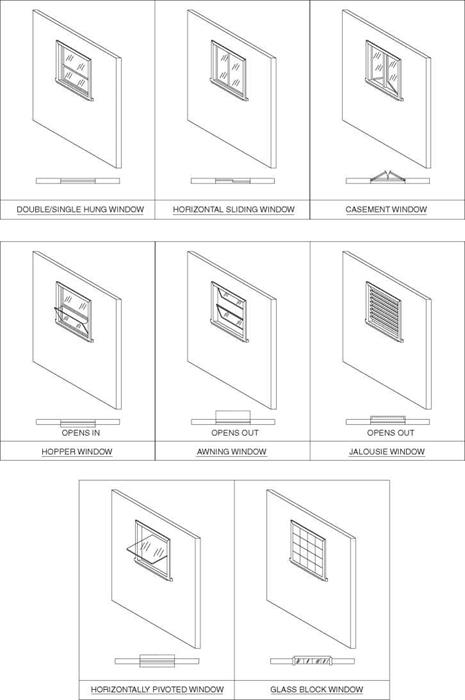The type, style, and size of window you choose for your bathroom will depend on the size of the bathroom, the intended use, the view, and where it will be placed. Small bathrooms may be very limited for window locations. Larger bathrooms may have multiple windows or even a sliding glass door to the outdoors. Whatever the size, windows are an important part of your design plan.
There are a number of common window styles that could be used in a bathroom (see Figure 2.5). These include:
• Single – or double-hung windows. Single – and double-hung windows are common window styles used in homes. In double-hung both sashes slide vertically, whereas only the bottom sash slides upward in the single-hung window. Many of these windows also have sashes that tilt inward for easy cleaning. These sliding windows generally have higher air leakage rates than hinged windows, and you usually need to be very close to the window in order to open it.
• Casement windows. Casement window panels are hinged at the side and crank open to a 90-degree angle, exposing almost all of the window area to the outside. This style has almost double the ventilation area compared to a double – or single-hung window, especially if there is a little breeze. Perhaps a downside to these windows is that the screen is on the inside of the window. Because the sash is closed by pressing against the frame, they have a lower air leakage rate than sliding type windows.
•
 |
Hopper and awning windows. Hopper windows are hinged at the bottom and open inward, and awning windows are hinged at the top and open outward. In both styles the sash closes by pressing against the frame, so they generally have a lower air leakage rate than sliding windows.
• Single – and double-sliding windows. Both sashes slide horizontally in a double-sliding window, and only one sash slides in a single-sliding window, opening part of the window at a time. Like the single – and double-hung windows, they have a higher air leakage rate.
• Decorative fixed windows. A second source of light and a decorative touch to a bathroom can be added with a variety of fixed windows. These windows can be octagon, square, round, or oval in shape and can be made with plain or decorative glass, such as stained, beveled, etched, or leaded glass. They can provide good natural light because they typically are not
covered on the inside and thus reveal their decorative nature. If placed high on the bathroom wall, people on the outside would not be able to see through them. However, if these windows are placed in the direct line of view as people walk through a bathroom or are bathing, then the windows will need to be shielded on the inside so that people in the bathroom cannot be seen from the outdoors. Even etched glass may shield a direct view but the shadows of individuals might still be seen.



